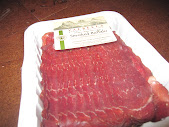Turns out, I should have started a little earlier in the day. But even still, I had a big bundle of curds in about 2 hours, with only about 15 minutes of that time requiring me to be busy.
First up - pour the jug of whole milk into a large pot, and over medium heat, warm the milk to 180 - 185 degress, just short of boiling. I used my meat thermometer, twist-tied to the pot handle to monitor temperature. Add a 1/4 tsp salt and stir occasionally, to ensure the milk doesn't scorch to the bottom of the pan. Once the milk reaches 180, remove from heat and add 1/3 cup white vinegar. Stir thoroughly to allow the acid to interact with the milk - it is this reaction that forms the curds. Let sit for 2 hours, or longer, if you can't get back to it quickly.
This is my 5 quart pot full of emerging curds - the vinegar was just on board. I was using the recipe from "Italian Food" http://italianfood.about.com/library/rec/blr0949.htm but "Italian Food Forever" talks about using a quart of buttermilk to create the reaction which I'll try another time.
 Not having cheesecloth, I drained the curds in a dampened, clean tea towel, inside a strainer over a bowl, because I wanted to catch and use the whey.
Not having cheesecloth, I drained the curds in a dampened, clean tea towel, inside a strainer over a bowl, because I wanted to catch and use the whey.I ended up squeezing the last of the whey out - it was late, I had to get to bed! - and I was afraid if I left it to drain all night, the ricotta would be too dry. Finished product: a 500 ml of fresh, home-made ricotta and about 3 litres of whey.
In photos: ricotta on left, whey on right.

 The ricotta I used crumbled over sauteed kale and garlic; topping a meatball and tomato sauce pasta; and in a baked cheesecake topped with a rhubarb - orange compote. (mmm - rhubarb. I crave it every spring)
The ricotta I used crumbled over sauteed kale and garlic; topping a meatball and tomato sauce pasta; and in a baked cheesecake topped with a rhubarb - orange compote. (mmm - rhubarb. I crave it every spring)

 The ricotta I used crumbled over sauteed kale and garlic; topping a meatball and tomato sauce pasta; and in a baked cheesecake topped with a rhubarb - orange compote. (mmm - rhubarb. I crave it every spring)
The ricotta I used crumbled over sauteed kale and garlic; topping a meatball and tomato sauce pasta; and in a baked cheesecake topped with a rhubarb - orange compote. (mmm - rhubarb. I crave it every spring) Whey substituted for water when making a half whole wheat version of no-knead bread dough for pizza; and I made corn muffins with it too. I also froze some by the cup in small freezer bags for future pancakes. It has the tang of buttermilk and can be used in its place.
Next time, I would add another teaspoon of salt at the point of adding the vinegar (the recipe gave this option if the curds wouldn't be used for dessert) as I found the ricotta bland. The curds were also firmer than I would have liked, so next time I'm going to try the buttermilk curdling option, which I think would be gentler, as well as letting them drain naturally instead of by brute force. If you have some time, it's definitely an easy way to create inexpensive ricotta.
I had fun, ate all the end result and will try it again. Experiment: successful.











